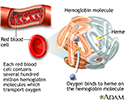Serum free hemoglobin test
Blood hemoglobin; Serum hemoglobin; Hemolytic anemia - free hemoglobin
Serum free hemoglobin is a blood test that measures the level of free hemoglobin in the liquid part of the blood (the serum). Free hemoglobin is the hemoglobin outside of the red blood cells. Most of the hemoglobin is found inside the red blood cells, not in the serum. Hemoglobin carries oxygen in the blood.
Hemoglobin
Hemoglobin is a protein in red blood cells that carries oxygen. The hemoglobin test measures how much hemoglobin is in your blood.

How the Test is Performed
A blood sample is needed.
Blood sample
Venipuncture is the collection of blood from a vein. It is most often done for laboratory testing.

How to Prepare for the Test
No preparation is necessary.
How the Test will Feel
When the needle is inserted to draw blood, some people feel moderate pain. Others feel only a prick or stinging. Afterward, there may be some throbbing or a slight bruise. This soon goes away.
Why the Test is Performed
Hemoglobin (Hb) is the main component of red blood cells. It is a protein that carries oxygen. This test is done to diagnose or monitor how severe hemolytic anemia is. This is a disorder in which a low red blood cell count is caused by the abnormal breakdown of red blood cells.
Hemolytic anemia
Anemia is a condition in which the body does not have enough healthy red blood cells. Red blood cells provide oxygen to body tissues. Normally, red ...

Normal Results
Plasma or serum in someone who does not have hemolytic anemia may contain up to 5 milligrams per deciliter (mg/dL) or 0.05 grams per liter (g/L) hemoglobin.
Normal value ranges may vary slightly among different laboratories. Some labs use different measurements or may test different samples. Talk to your health care provider about the meaning of your specific test results.
What Abnormal Results Mean
A higher-than-normal level may indicate:
-
A
hemolytic anemia
Hemolytic anemia
Anemia is a condition in which the body does not have enough healthy red blood cells. Red blood cells provide oxygen to body tissues. Normally, red ...
 ImageRead Article Now Book Mark Article
ImageRead Article Now Book Mark Article -
Condition in which red blood cells break down when the body is exposed to certain drugs or the stress of infection (
G6PD deficiency
)
G6PD deficiency
Glucose-6-phosphate dehydrogenase (G6PD) deficiency is a condition in which red blood cells break down when the body is exposed to certain drugs or t...
 ImageRead Article Now Book Mark Article
ImageRead Article Now Book Mark Article - Low red blood cell count due to red blood cells breaking down sooner than normal
-
Blood disorder in which red blood cells are destroyed when they go from cold to warm temperatures (
paroxysmal cold hemoglobinuria
)
Paroxysmal cold hemoglobinuria
Paroxysmal cold hemoglobinuria (PCH) is a rare blood disorder in which the body's immune system produces antibodies that destroy red blood cells. It...
 ImageRead Article Now Book Mark Article
ImageRead Article Now Book Mark Article -
Sickle cell anemia
Sickle cell anemia
Sickle cell anemia is a disease passed down through families. The red blood cells that are normally shaped like a disc take on a sickle or crescent ...
 ImageRead Article Now Book Mark Article
ImageRead Article Now Book Mark Article -
Disorder in which there is excessive breakdown of hemoglobin (
thalassemia
)
Thalassemia
Thalassemia is a blood disorder passed down through families (inherited) in which the body makes an abnormal form of hemoglobin. Hemoglobin is the p...
 ImageRead Article Now Book Mark Article
ImageRead Article Now Book Mark Article -
Transfusion reaction
Transfusion reaction
A hemolytic transfusion reaction is a serious complication that can occur after a blood transfusion. The reaction occurs when the red blood cells th...
 ImageRead Article Now Book Mark Article
ImageRead Article Now Book Mark Article
Risks
Veins and arteries vary in size from one person to another and from one side of the body to the other. Obtaining a blood sample from some people may be more difficult than from others.
Other risks associated with having blood drawn are slight, but may include:
- Excessive bleeding
- Fainting or feeling lightheaded
- Hematoma (blood buildup under the skin)
- Infection (a slight risk any time the skin is broken)
References
Bunn HF. Approach to the anemias. In: Goldman L, Schafer AI, eds. Goldman's Cecil Medicine . 25th ed. Philadelphia, PA: Elsevier Saunders; 2016:chap 158.
Steinberg MH, Benz EJ, Adewoye AH, Ebert BL. Pathobiology of the human erythrocyte and its hemoglobins. In: Hoffman R, Benz EJ Jr, Silberstein LE, Heslop HE, Weitz JI, eds. Hematology: Basic Principles and Practice . 6th ed. Philadelphia, PA: Elsevier Saunders; 2013:chap 31.
-
Hemoglobin - illustration
Hemoglobin is the most important component of red blood cells. It is composed of a protein called heme, which binds oxygen. In the lungs, oxygen is exchanged for carbon dioxide. Abnormalities of an individual's hemoglobin value can indicate defects in the normal balance between red blood cell production and destruction. Both low and high values can indicate disease states.
Hemoglobin
illustration
-
Hemoglobin - illustration
Hemoglobin is the most important component of red blood cells. It is composed of a protein called heme, which binds oxygen. In the lungs, oxygen is exchanged for carbon dioxide. Abnormalities of an individual's hemoglobin value can indicate defects in the normal balance between red blood cell production and destruction. Both low and high values can indicate disease states.
Hemoglobin
illustration
-
Diabetes
(Alt. Medicine)
-
Rheumatoid arthritis
(In-Depth)
Review Date: 2/11/2016
Reviewed By: Todd Gersten, MD, Hematology/Oncology, Florida Cancer Specialists & Research Institute, Wellington, FL. Review provided by VeriMed Healthcare Network. Also reviewed by David Zieve, MD, MHA, Isla Ogilvie, PhD, and the A.D.A.M. Editorial team.

